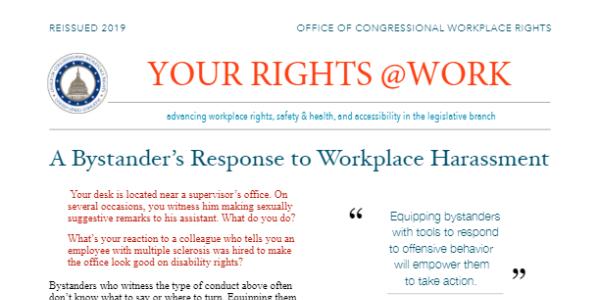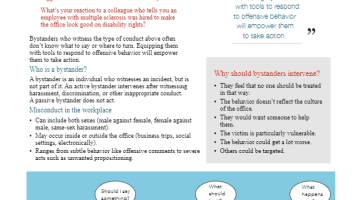Your desk is located near a supervisor’s office. On several occasions, you witness him making sexually suggestive remarks to his assistant. What do you do? What’s your reaction to a colleague who tells you an employee with multiple sclerosis was hired to make the office look good on disability rights?
Bystanders who witness the type of conduct above often don’t know what to say or where to turn. Equipping them with tools to respond to offensive behavior will empower them to take action.
Who is a bystander?
A bystander is an individual who witnesses an incident, but is not part of it. An active bystander intervenes after witnessing harassment, discrimination, or other inappropriate conduct. A passive bystander does not act.
Misconduct in the workplace
- Can include both sexes (male against female, female against male, same-sex harassment).
- May occur inside or outside the office (business trips, social settings, electronically).
- Ranges from subtle behavior like offensive comments to severe acts such as unwanted propositioning.
What else can you do?
- Take notes on the behavior you just witnessed. Include the date and what you saw and heard.
- If you feel comfortable, let the victim know that you would be willing to describe the incident if there is an investigation.
- If you do not feel comfortable talking to either the harasser or the victim, follow your office’s internal procedures for reporting incidents. If your office does not have a procedure, try talking to a neutral supervisor. You can also contact the OCWR. If the conduct continues, stay close by because your presence may prevent the situation from escalating.
What if you are a supervisor or manager?
- Foster an environment that gives employees the tools they need to be responsible bystanders. This includes developing office standards of conduct and policies that outlines clear expectations for behavior and possible discipline for violating those standards.
- Apply policies consistently and act immediately when problems are reported. If there is a fair process available to address workplace incidents, employees will be more likely to intervene.

